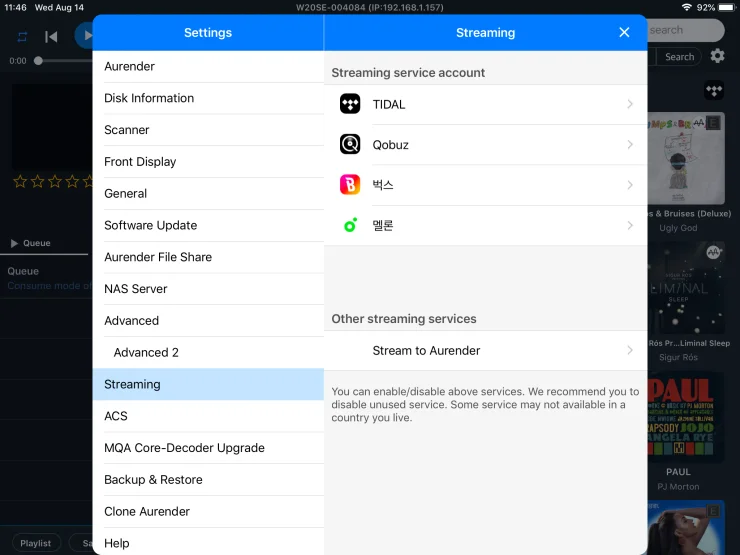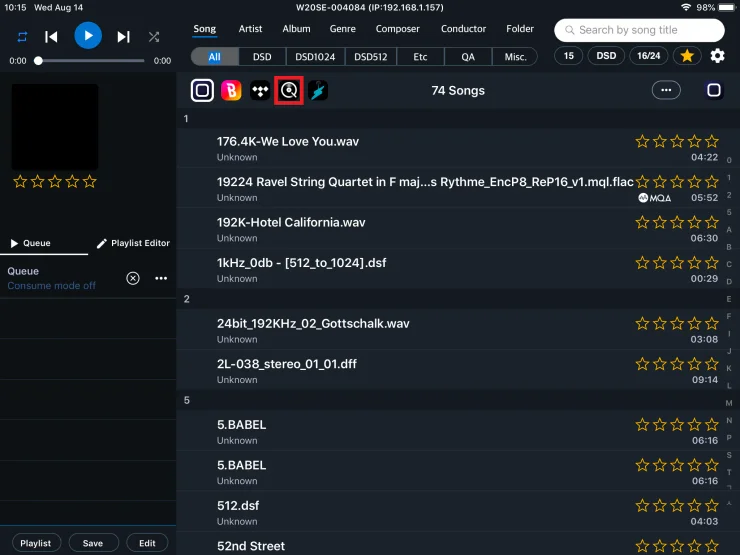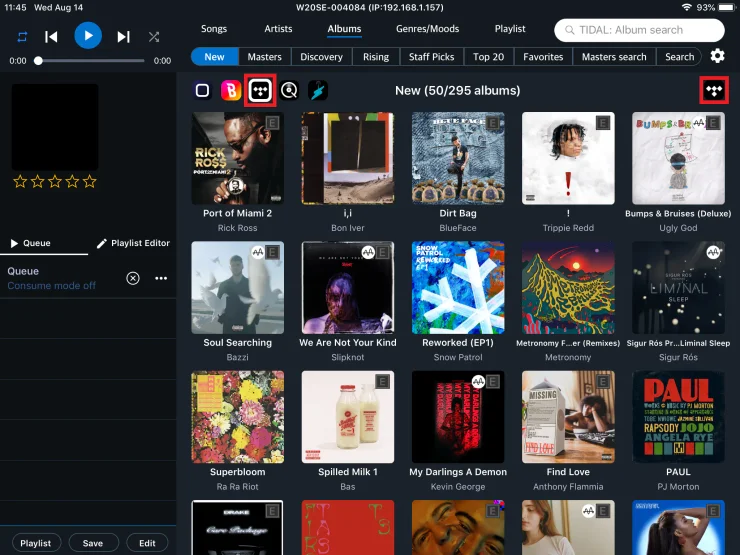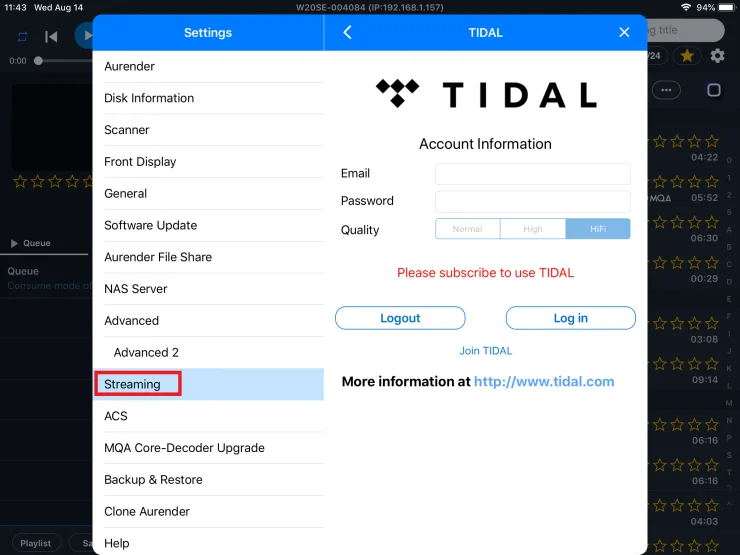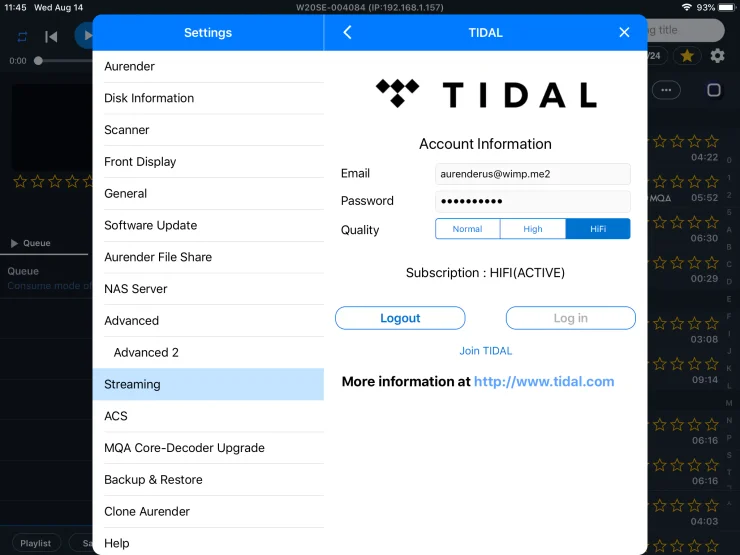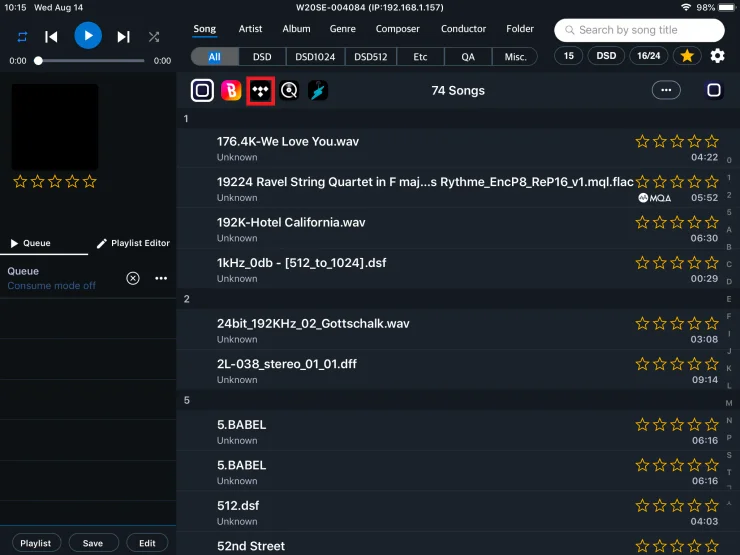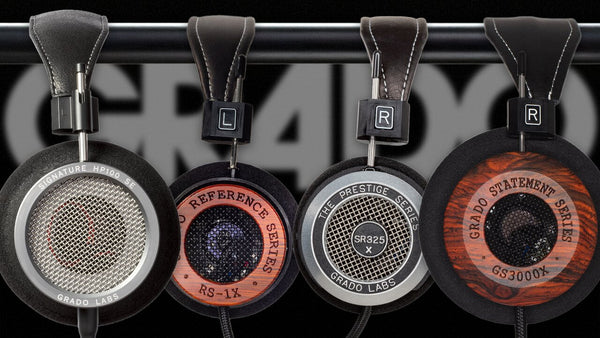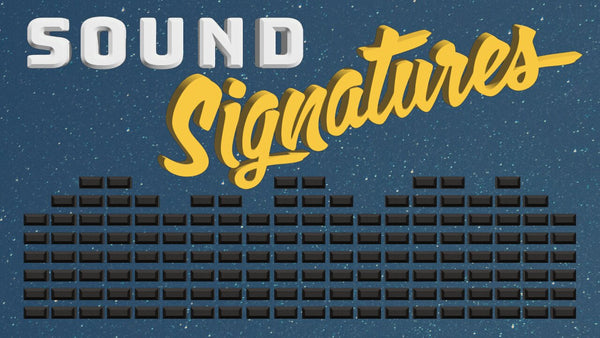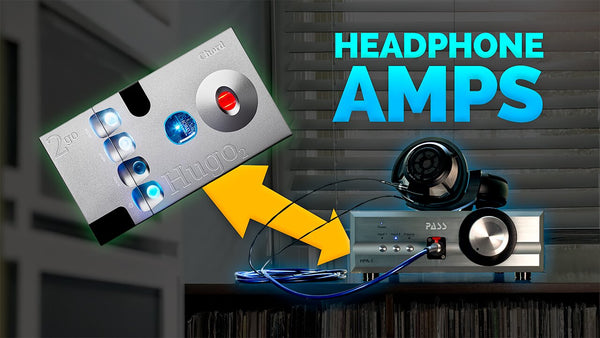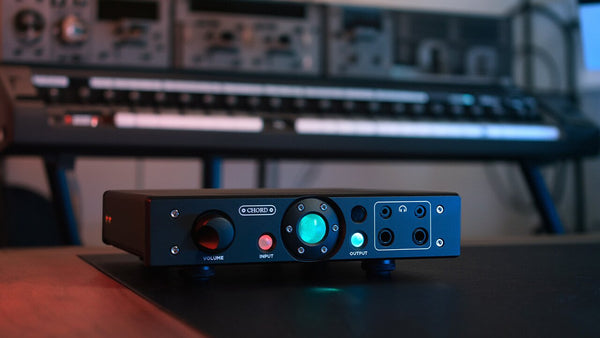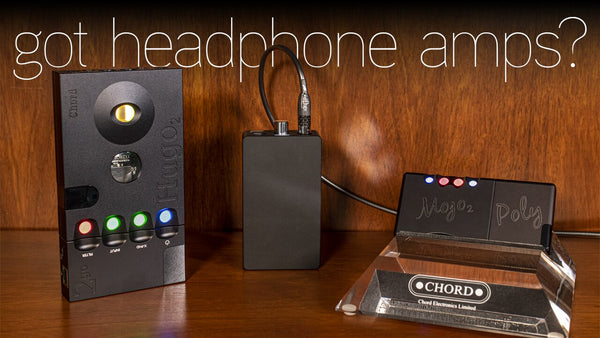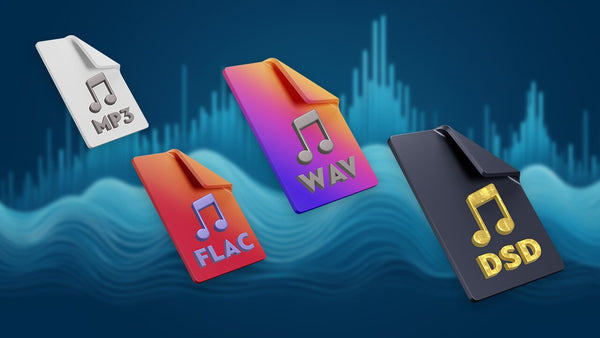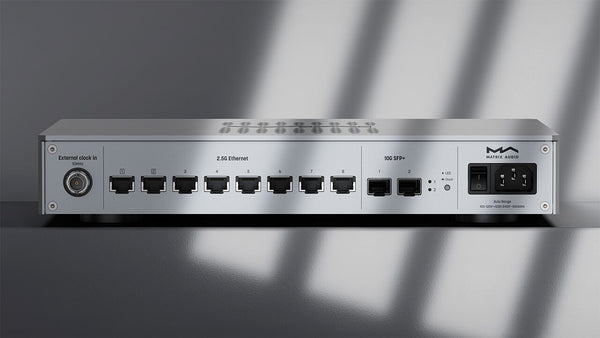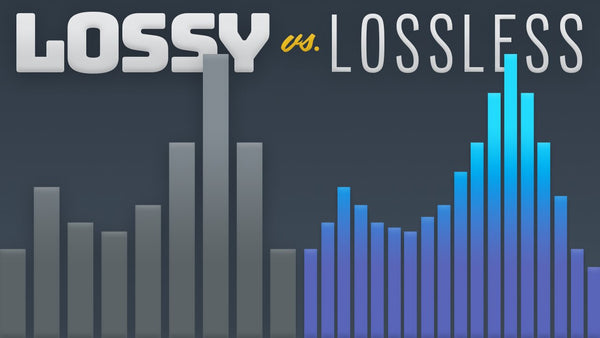Navigating Aurender's Complete Product Lineup: From Entry-Level to Reference Streamers
Read Time: Approx. 25 min.

Investment in Sound: Aurender's Price-to-Performance Ratio Across Models
Beginning with its first music server nearly 10 years ago, Aurender has consistently raised the bar when it comes to build quality and audio fidelity. Designed with the digital streaming enthusiast in mind, Aurender creates world-renowned audio products to help you get the most from your digital audio experience. Whether you're looking for a music server, a server with CD ripper, a server with a built-in DAC, or an all-in-one solution, Aurender offers well-designed, great-sounding, user-friendly products. As streaming becomes more popular, Aurender is here to elevate the experience of listening to that content.
The Aurender Product Line
Aurender Entry-Level Options: Smart Decision for the Sound Obsessed
The N150 and the ACS100 are the lowest-priced streamer/server options from Aurender, but they are still very much designed for the discerning audiophile. Both models feature optional storage in the form of pull-out trays that accommodate HHD or SSD drives. The ACS100 incorporates a CD ripper that will integrate directly with the Acronova Nimbie USB Plus, which Moon Audio rents to Aurender customers. (You can still use the Nimbie with the N150 or other models without a CD ripper, but you will need to connect it to your computer.) As with all Aurenders without a DAC, these models offer MQA Core Decoding via an optional in-app purchase.
Aurender A1000 Network DAC
The missing addition to your audiophile setup, the Aurender A1000 Network DAC is a music server, streamer, and DAC with versatile input/output options for seamless system integration. The A1000 is a hi-fi unicorn capable of acting as a preamplifier with HDMI ARC input, robust connectivity, and across-the-board versatility. Unlock next-level audio performance with this dynamic-sounding music server/streamer equipped with a brilliant-sounding AKM 4490REQ dual-mono DAC chip and Quad-core 2.0GHz ARM Cortex-A55 CPU—each fueled by their own linear power supply—translate to playback that's rich, smooth, detailed, and fast. The Aurender A1000 Network DAC represents the next generation of hi-fi components with Bluetooth AptX HD and Chromecast Audio allowing users to wirelessly cast sound output from a variety of mobile devices. Whether you're enjoying background music or focusing on a critical listening session, you can put the screen down and comfortably manage your queue using the fully-equipped Bluetooth LE Remote Control.
Aurender Streamers: A Step Up
The ACS10, A200, and N200 represent a step up in the Aurender line. The ACS10 shares many features with the ACS100, but has an internal hard drive, a linear power supply, and other upgrades. The A200 digital output server is a newer model from Aurender and features a DAC and user-installed storage. The new N200, meanwhile, features an all-new low-power Intel quad-core processor, low-noise linear power supply, and enhanced system memory over its predecessor.
Aurender ACS10 Music Server with CD Ripper
Designed as the one-stop solution for digital music management, the Aurender ACS10 has everything an audiophile needs for a high-end playback system. The ACS10 features a caching music server with a CD ripper, content storage, library management, and meta-tag editor. It can be used as a companion to your existing Aurender Music Server or as a music server/streamer when connected to a USB DAC via the USB output. Available in two different terabyte sizes, the ACS10 can be purchased with 16TB of storage or 24TB of storage. The Aurender ACS10 is the perfect comprehensive solution for those looking to combine CD ripping, music storage, and high-quality playback in a single device.
Aurender A200 Music Server Preamplifier and DAC
Love your Music the "Aurender Way," at a real-world price. The A200 music streamer and network server delivers unrivaled performance and replaces the A100 as Aurender's most compact and economical Analog Output Network Player. The A200 offers the renowned Aurender user experience - a premium streaming application that gives you everything you need for your music. The A200 is an ideal choice for the music lover building a high-performance yet affordable digital audio system. The A200 is meant for the audiophile who has an extensive local digital music library, with 2 drive slots, you can install the largest capacity 2.5-inch drives needed for an incredible amount of local storage for your library. You can even connect external storage for additional options to expand your local music library. With analog outs and coax and optical digital ins, The Aurender A200 is the new high-end music streamer and network server to beat at this price.
Aurender N200 High-Performance Music Server
Get the most out of your home audio system by adding the Aurender N200, a high-performance caching music server. As a dedicated high-performance digital output network transport the N200 does not have an internal DAC, requiring connection to an external DAC of your choice, and has no analog outputs. Its combination of exceptional audio performance, unique feature set, and high-end build quality make the N200 a highly desirable model within the Aurender range. The N200 is the updated and improved version of the N100SC offering an all-new low-power Intel quad-core processor, low-noise linear power supply, and increased system memory. The result? Higher fidelity to your digital files and streams. The unit supports all the recent Aurender innovations like cache-based playback, the latest-generation modular USB audio output, double isolated gigabit ethernet port, and super-capacitor-based uninterruptible UPS. Capable of handling PCM up to 384kHz and DSD up to DSD512, the Aurender N200 is a high-quality music server designed for audiophiles and music enthusiasts who are passionate about great performance.
Aurender Streamers:The Next Level
The A15 is an upgrade over the A10, which was Aurender's first streamer/server with a built-in DAC. The A15 has many new features and sound improvements. It's a great choice for the audiophiles replacing an old CD player or laptop, or who just wants the simplicity and ease of a one-box source component. The A15 has balanced analog outputs and a resolving dual-mono AKM4490 digital-to-analog convertor with MQA full-decoder technology. As with all of Aurender's "A" series, A15 is designed to take full advantage of the vast selection of MQA encoded music available today. It also has two rear panel bays which can accommodate user-installable 2.5" HDDs or SSDs of up to 8TB each. An elegant front panel display shows album cover art along with artist name and song title in color.
Jumping up in price to the N20, a notable feature is the inclusion of AES digital outputs, which is better than USB. When computer audio first started to gain popularity, USB was the de facto standard for digital audio signal transport. This was simply because computers have USB ports, not AES/EBU or other SPDIF ports. Unfortunately, USB can be a flawed protocol for digital audio transmission as it is prone to noise, jitter, and compatibility issues. Done properly, AES/EBU and SPDIF audio outputs represent a superior method of audio transmission with nearly universal compatibility, less jitter, and greater ease and flow to the overall musical presentation.
Aurender A15 DAC Music Server
The upgraded replacement of the Aurender A10, the A15 DAC Music Streamer combines advanced digital audio technology with user-friendly features. The Aurender A15 is an ultra high-performance analog output network player with a dual-mono MQA full-decoder DAC, RCA, and balanced XLR analog outputs. As with all of Aurender's 'A' series, the A15 is designed to take full advantage of the vast selection of MQA-encoded music available today. It also has two rear panel bays which can accommodate user-installable 2.5″ HDDs or SSDs of up to 8TB each to store the largest of music libraries. The Aurender A15 represents a well-balanced blend of high-end digital audio technology, excellent sound quality, and user-friendly features, making it an attractive option for those seeking a comprehensive digital audio solution in a single unit.
Aurender N20 Streaming Music Server
Enjoy a high-quality music streaming experience with the Aurender N20 Music Server and Streamer, designed for home audiophile systems. The N20 Music Server and Streamer is a high-performance digital audio transport featuring digital outputs (no analog) only that can be connected to an external DAC for a complete high-end digital audio front-end solution. Complete with USB, AES/EBU, Coaxial, BNC, optical outputs, a word clock input, and two user-installable storage slots, the N20 Music Server and Streamer is a flexible unit that delivers stability, speed, and great sound quality. Sitting in the middle of Aurender's range of digital source components, the N20 offers exceptional performance, combining robust server capabilities with high-quality streaming functionality. If your home audio system is missing a streamer, pair the N20 with your favorite DAC and enjoy higher-quality sound.
Aurender Streamers:The Next Level
For the listener looking for a high-performance, one-box source component, Aurender has the A20 and the A30. We call these the "kitchen sink" models. Audio performance for the A20 and the A30 is identical. The differences lie in the features and functionality of each.
The A30 is Aurender's flagship analog output server. The A30 is, at its essence, a caching music server / streamer with internal storage and control via Aurender Conductor. The Aurender A30 also includes full MQA Decoder technology which enables you to play back full-resolution MQA audio files and streams, delivering the highest possible sound quality of the original master recording. What distinguishes the A30 from the others is the pure audio performance and exhaustive feature set. Aurender has designed the A30 to be the comprehensive digital focal point of your system providing useful aides not usually associated with a typical music server. Functions like CD ripping, a high-quality headphone amplifier, 10TB of internal storage, ultra-wide color LCD display and an integrated software suite of metadata editing and library management tools. All this, and much more, makes the A30 the new performance standard in all-in-one digital source components. And because the A30 is so packed with features, it has its very own app! The A30 Manager companion app is used to configure all system settings including CD ripping preferences and behaviors. Smart Copy, Move, Delete, Editing and Duplicate Checker are just some of the library management software-based tools provided allowing you to organize your music library the way you want.
The A20 shares the same basic circuitry topologies and form factor as the flagship A30. However, it dispenses with the CD ripping functionality, metadata editing software and the headphone connection provided is a single standard ¼” jack. What distinguishes the A20 from other analog output models is its pure audio performance. Employing the world-renown AKM 4497 chipset in a dual-mono with dual linear power supplies, you can expect nothing but the best in sound quality. Also included is full MQA Decoder technology which enables you to play back full-resolution MQA audio files and streams, delivering the highest possible sound quality of the original master recording. Since many audiophiles will use the A20 as their “digital hub,” the ability to reduce system complexity is easily achieved. For example, the A20 can function as a preamplifier, allowing for direct connection to a stereo power amplifier or active speaker system. The preamp section has both SPDIF and optical inputs that allow other source components like a CD transport, Blu-Ray player or cable box to feed its audio through the A20’s DAC improving fidelity. Lastly, the system volume can be controlled three ways; the front panel rotary control, the Aurender Conductor app or using the supplied IR remote control.
Aurender A20 Music Server
Derived from the Aurender A30, the A20 Music Server delivers the very same reference-level audio performance, but without the CD ripping and library management functionality. The Aurender A20 features a MQA full-decoder DAC and integrated headphone amplifier for the ultimate high-quality playback system. The A20 also replaces the A30's factory-fitted 10TB HDD storage with two user-installable storage bays that support a 2.5" HDD or SSD. Employing the same renowned dual-mono AKM4497 DAC chipset found in the A30 model, you can expect nothing but the best in sound quality. The Aurender A20 represents a sophisticated blend of cutting-edge digital audio technology, audiophile-grade performance, and user-friendly features, making it a compelling choice for those seeking a high-end music server solution.
Aurender A30 Music Server Preamplifier, Headphone Amplifier, and DAC with CD Ripper
Digitize your entire CD collection with the Aurender A30, a caching music server and integrated CD ripper. The A30 combines many of the features of the Aurender ACS10 with Aurender's highest-performance server and D/A converter design yet. It's got loads of functionality as a caching music server, streamer, CD ripper, HDD storage, headphone amplifier, and DAC. Equipped with a professional-grade slot-loading CD-ROM ripping drive and 8TB of internal storage, the A30 is the answer for archiving your entire CD collection. Advanced library organization including metadata editing, content organization, duplicate detection and removal, and copy/move/delete tasks are possible with Aurender's own A30 Manager Companion App. The A30 is designed to be a comprehensive solution for audiophiles and music lovers, offering high-quality digital-to-analog conversion, ample storage, and the convenience of CD ripping in a single device. It's a great unit for those who want a streamlined, high-end audio system without the need for multiple separate components.
Who is Aurender?
In 2011, early on in the computer audio revolution, a South Korean company called WideaLab released the first Aurender product, the S10 reference music server. The man at the helm of the company was Harry Lee, an engineer and music lover who assembled a team of like-minded engineers to produce a music server that would meet his high standards. Lee's goal was lofty but simple: to produce something that he himself would be willing to purchase and proud to own.
The S10 garnered international acclaim. But Lee had his sights on something more. While designing Aurender's next server, the W10, he joined up with a former engineering classmate, K.K. Lee, the founder of TVLogic. Also based in South Korea, TVLogic designs and manufactures high-end television monitors. The two ended up making a deal in which TVLogic acquired WideaLab. Harry became the director of the Smart Audio Division of TVLogic and brought his team of engineers with him.
With enhanced resources, the Aurender team was able to start designing and building custom servers around its own boards rather than using commercially available ones. Today, Aurender continues to build high-quality audio products for both audiophiles and music lovers who want to enjoy operational convenience, simplicity, and excellent sound quality. Its award-winning products are developed and manufactured in South Korea. Product design and marketing is done in California.

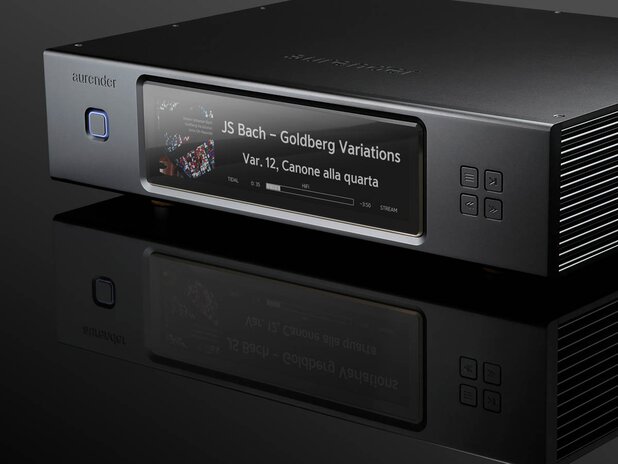
A Top-Notch Experience
Aurender's current lineup includes a range of music servers, music servers with CD rippers, music servers with internal DACs, and an "all-in-one" music server that includes a DAC, CD ripper, headphone amp, and preamp.
But this is only part of the story. Amazing customer service and an award-winning app elevate the Aurender experience. Perhaps one of the best things about Aurender is its Conductor app. Aurender is one of the few hardware companies that have done a great job of providing a well-thought-out and powerful app for controlling your music library. After all, the way you browse for and catalog your music is part of the experience. The Conductor app was designed and developed exclusively to control Aurender Music Servers/Streamers. Available for Android tablets and iPads, it allows swift and easy access to your music with an interface that is free of complexity and visual clutter. The Conductor app incorporates the whole experience of browsing for and discovering new music and ensures easy access and swift browsing of your file-based or streaming music, handling even the largest libraries with ease.
Conductor delivers high-res music from your own internally stored music library or from a subscription streaming service like Tidal or Qobuz. When you create a playlist, it will look like everything is coming from one integrated library. You can save recordings that you discover while streaming, and you can easily create playlists. It's easy to add/edit/remove content from your library.
A really nice perk with Aurender is remote support technical assistance. If you experience a glitch in your server, you can put it into maintenance mode. Then, a technician will go in and troubleshoot. (Remember that the company is based in South Korea, so depending on your time zone, this will most likely occur while you are sleeping!) This is a premium service that comes standard with any Aurender product.
Now, with high-res streaming becoming the norm for many audiophiles, the need for hard drive storage has lessened. Aurender developed a solution that satisfies the needs of both the file collector and the streaming enthusiast:: optional storage. Some Aurender models come with internal storage (up to 12TB), while others allow you to add storage (traditional hard drive or solid state drive) to best meet your budget and intended use.
All servers are firmware upgradable; there's an update button in the Conductor app. You will be asked if you want to initiate updates when you log in.
Connecting Your Aurender Music Streamer
The general setup of an Aurender home audio system looks like this:

As you can see, the basic setup starts at a wireless router that is then connected to your Aurender. The router provides both a gateway to the Internet for your Aurender as well as the wireless connection to your tablet that hosts the Aurender Conductor app. A wired LAN connection to your router is always the most reliable connection for your Aurender. But in some cases, you might be forced to use a wireless dongle or better yet a wireless access point that has a LAN wired connection. Please contact us if you require such a setup and we can help guide you to an applicable device available at the time of your purchase. Below is the rear of a router and a typical ethernet LAN cable.


Aurender Music Server to USB DAC
Depending on which model you have chosen, the Aurender might be then connected to a DAC, preamplifier, or headphone amplifier. With some of the Aurenders, you may just connect it directly to a speaker amplifier. There are lots of possibilities. When using your Aurender with a DAC, in most cases, the USB connection is the most ideal. It will allow the transfer of more digital data stream formats than the other digital output connections on the Aurender. In some cases your DAC may not have a USB connection; in these situations, picking the right model for your connection type is important.
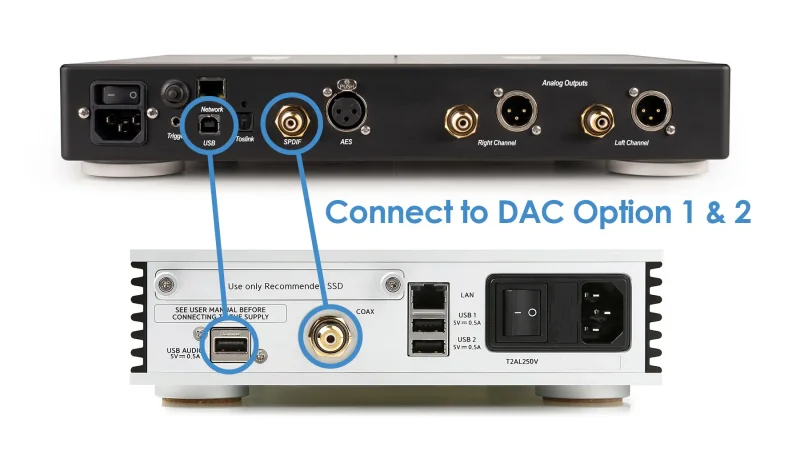
For a quick and easy connection between an Aurender music server and a USB DAC, we suggest using a USB audio cable. Your USB cable will require a USB A to USB B connection in most cases. But don't worry if your DAC has a special connection variant -- we can help. Our Dragon USB cables are built to order and we can help you choose the correct one for your needs. Moon Audio creates custom Dragon USB cables that can easily fit the USB connections of most home audio setups. Learn more about our upgraded Dragon USB Cables.
Notice there are two and sometimes more USB connections on the rear of the Aurenders. There is a primary one that says USB Audio and the others are meant for connecting external USB drives. We always recommend self-powered USB drives, thus eliminating a USB power draw from the Aurender. Keeping power isolation separate is always better.
With some of the higher-end models like the W20SE, you will have multiple digital output options. We recommend trying a variety of them to see what sounds best with your DAC.
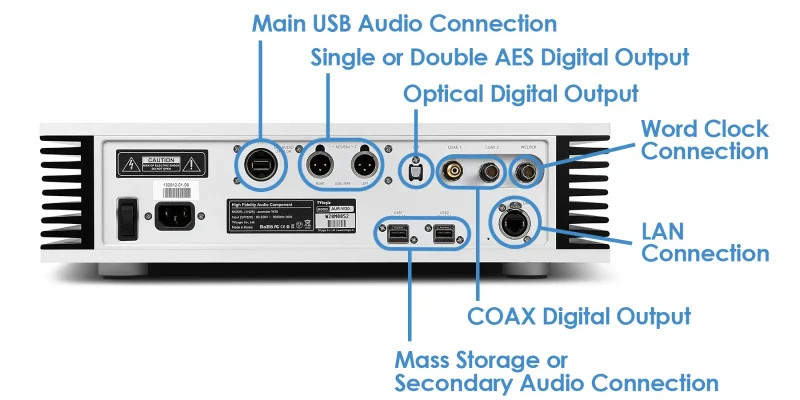
The A15, A20, A30, and A200 have built-in DACs. With these models, you would use normal interconnects to go to your preamplifier, amplifier, or headphone amp. These models also have volume controls, allowing them to be directly connected directly to a speaker amplifier if desired.
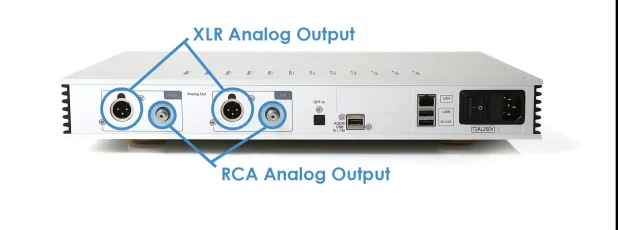
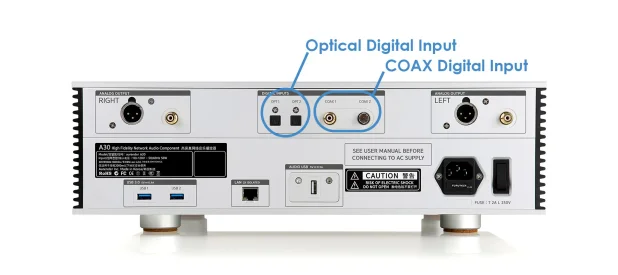
In the case of the A20 and A30, you have the choice of either RCA or XLR connections. Balanced in almost all cases is always more ideal when given both options. A great option for your interconnects here would be Black Dragon interconnects. The A20, A30, and A200 have digital inputs since they have internal DACs. This will provide a great way to resurrect the sound of an older digital transport or even for connecting your TV to. The benefits of the great D to A conversion by the Aurender pieces can breathe new life into your other gear.
As you can see, there are lots of connection options with these wonderful music servers. Please feel free to reach out to us with any of your connection questions.
Aurender Music Storage
Expand to Read
Streaming Music on Your Aurender Device
Qobuz and Tidal give you the ability to stream high-resolution files directly to your Aurender devices. Both services are embedded in the Aurender Conductor app; you will need to purchase subscriptions separately.
Streaming Qobuz on Aurender
1) In the Aurender Conductor App, open settings. Click on Streaming, then select Qobuz
2) Enter username and password. Select streaming quality. Hi-Res will be only available for tracks you purchased in Hi-Res format. If selected track to play is not purchased track, it will be streamed at 44.1kHz.
3) Once logged in, the Qobuz icon will be displayed in the summary section
Streaming TIDAL on Aurender
1) Download the Aurender Conductor App from the Apple App Store
2) Run the Aurender Conductor App and click the Settings icon. (If you are prompted to upgrade to the new system software please do so)
3) Choose "Streaming Setup" Menu
4) Enter username and password
5) Click Check Login
6) Change menu bar selection (for example, from Artist to Album or Album to Song)
7) You will see "TIDAL Icon" on the title bar and touch "TIDAL Icon"
8) Title bar display will change from Aurender to TIDAL and you will see the TIDAL menu and albums. (If you cannot see TIDAL menu but only see waiting icon, exit the Aurender Conductor App and run the app again)
Dragon Cables for Aurender Music Servers
We recommend using Dragon Audio Cables to maximize the performance of your Aurender home audio system. Aurender puts a lot of thought into its music servers, equipping them with state-of-the-art features and capabilities. Dragon cables will be the icing on the cake that will elevate your system to the next level.
Dragon cables are made with ultra pure, single-crystal silver or copper strands. Our wire is void of impurities and crystalline boundaries, leaving nothing between you and your music. When you mix Dragon Audio Cables with the Aurender product line, you are creating an environment designed by and for music lovers.
Dragon Audio Cables: Deciphering the Differences
When you see Black, Silver, and/or Blue options for our analog and digital Dragon cables, you may be wondering how to choose.
With analog cables (interconnects, speaker cables, and headphone cables), you will find variations in coloration or sound signature. With these cables, the Silver Dragon lends detail and clarity with top-end sizzle; the Black Dragon enhances the bottom end and gives a warm, full sound; and the Blue Dragon is calm and neutral.
With digital cables, the sound characteristics are more about the resolution and detail in the music. We find the characteristics of digital cables act similar to that of digital filters options on DACs. Shaping the filter on the D to A with either a sharp or gentle roll-off sounds similar to our ears. Thus, we only have a couple of digital cable options.
In the coax SPDIF category, for example, we offer a Silver Dragon digital cable that is the most resolute of our digital cables and based on our UP-OCC silver conductor technology. It was a no-holds-bared design for the best possible signal transfer. It is also the most flexible cable for tight turns in your equipment rack.
The Black Dragon is a copper-based digital cable and has an extra layer of shielding, utilizing a capacitor as a noise blocker. It was designed for noisy environments, when computer audio cards were more popular and required cabling that would ward of interference from being behind a cable ridden noisy computer environment. It was also intended for use in studios where cables run all over the place and quiet signal transfer is a must.
USB Cables
All Aurenders come with a USB output. In most cases, this is the most desirable Audio output. The USB can output PCM audio streams as well as DSD.
Upgrading to Dragon USB cables will help you optimize your Aurender home audio system. The most important consideration with USB cables is that they are designed to true USB specifications. In other words, the geometry of a USB cable is very important to the transfer of digital data transmission. Many of the cheap USB cables you buy at a computer or electronics store don't follow the standard specifications required for USB cables, resulting in potential issues with data packet loss, etc. Dragon USB cables were designed to adhere to USB specifications and use the highest quality materials to ensure a proper and protected digital transfer.
Moon Audio produces both a Silver Dragon and a Black Dragon USB cable. The Silver Dragon utilizes UP-OCC silver and the Black Dragon uses UP-OCC copper. The silver is more resolute, but really both are fantastic digital transfer cables. In most cases, this is the most flexible digital transmission medium in terms of data transfer over the other digital cables we discuss on this page. The USB cable will allow for both PCM and DSD transfer from your Aurender to your DAC. Whether USB sounds better vs. the other mediums we have talked about really comes down to the design of the digital circuit in your DAC. So if the Aurender model you purchased has more than one option and so does your DAC, we recommend experimenting to see which is most desirable to your ears.
AES Cables
The higher-priced Aurender N10, N20, and W20SE have multiple digital outputs. These can output PCM audio streams but also DSD via all-digital output. However, a compatible DAC must have the ability to process DSD digital stream via these formats to work. If the DAC can only do PCM, then the higher-level Aurender units use the best in FPGA digital conversion to convert DSD to PCM without any discernible sound difference.
Why would you use some of these digital outputs over USB? In some cases, the DAC design may sound better from one of these formats. USB can sound better in some DAC designs and vice versa. Thus you have some flexibility to find the best transfer possible based on your DAC.
Our Black Dragon AES/EBU balanced digital cable is a hybrid design implementing a silver-plated copper conductor. For the Aurender players that have this option, this is the best digital format. Whereas standard SPDIF coax cables utilize a 75ohm impedance, these offer 110ohm. We use a double shield to avoid low- and high-frequency interference, and the higher impedance allows for more data transmission. With the W20SE, you can do dual data digital output via the two AES digital outputs, allowing for a higher-resolution data transfer to your DAC.
Coax Cables, Toslink Cables, and Interconnect Cables
The Aurender W20SE and N10 feature a coax digital output. Additionally, Aurender has added a coax digital output on the N100C and N100SC in case the user has a legacy DAC that does not have a USB input.
The Aurender A10, A100, A30, N10, and W20SE have toslink inputs. This can come in handy for your other digital sources -- maybe a CD player you still use for spinning discs. The DAC in the Aurender might be a much newer design than what was implemented in your CD player, thus offering new life to your CD collection.
If you find your system sounds too forward, Black Dragon interconnects might be best. If you're looking for more detail and resolution, the Silver Dragon is the way to go. The Blue Dragon, meanwhile, is a neutral cable that will add another layer of clarity to your music.
Power Cables
Dragon Power cables will fuel your Aurender system without noise interference from your electrical sources. The Black Dragon Power Cord features 4x 21.5 AWG UP-OCC copper conductors. The Blue Dragon Power Cord is an amazing "bang for the buck" power chord, with 3x 12 AWG UP-OCC copper conductors.
Related Videos
Aurender: Everything Audiophiles Should Know
Aurender A200 Caching Music Server Review: The Best of Its Kind
Aurender A30 vs. A20: Music Server Review & Comparison



